Can a Non-Native Heal the Land? Rethinking Rewilding and Ecological Surrogates

There’s a tension I keep returning to as a first-generation farmer trying to repair a wounded landscape: can we restore what's been lost without replicating it exactly?
In rewilding circles, there’s a growing conversation around ecological surrogates—species that aren’t native, but step into the role of one that’s been lost. Whether it’s wolves bringing balance back to Yellowstone or cattle mimicking extinct megafauna to restore grasslands, the idea is this: it’s the function that matters, not the name on the tag.
But as someone planting native chestnuts on Appalachian soil while eyeing Korean stone pines with admiration, I have to ask:
Where is the line between healing and harm? Between ecological repair and well-meaning invasion?
Ecological Surrogates: Function Over Origin?
An ecological surrogate is a species introduced to fill the niche of one that’s missing. Sometimes that’s because the original went extinct. Sometimes it’s because humans pushed it out. Either way, the goal is to restore function—nut cycling, predator-prey dynamics, seed dispersal—not necessarily the exact species.
In practice, this might mean:
- Letting water buffalo graze in place of aurochs
- Using cattle in prairie restoration where bison once roamed
- Replacing extinct megafauna with large herbivores to bring back soil disturbance and seed spread
And sometimes? It might mean planting a nitrogen-fixing non-native tree where native options are failing under current conditions.
The Case for Native-First
There’s a compelling reason to start with native-first rewilding. Native plants co-evolved with native insects, fungi, and wildlife. They’re the backbone of resilient ecosystems. Native-first approaches reduce the risk of disruption and honor the ecological memory of a place.
Where I farm, this means looking to serviceberry before pawpaw before persimmon before some exotic fruit I saw in a permaculture group online. It means trusting that maybe what grows slow is still the right choice. But it also means facing the fact that the landscape has already changed—climate, soil, hydrology, and all.
So then what?
A Gray Zone: Thoughtful Introductions or Trojan Horses?
Let’s say you plant a non-native tree—one that doesn’t escape into the wild, doesn’t outcompete native species, and fills a critical niche. Maybe it provides food. Shade. Fodder. Or brings back a soil function long missing.
Is that restoration or risk?
The answer is: it depends.
And it’s why this work isn’t a recipe—it’s a relationship.
A thoughtfully introduced species might:
- Be sterile or non-aggressive in seed dispersal
- Coexist with, not crowd out, native plants
- Offer ecological benefits in a disturbed or degraded site where natives can’t establish
But even the best intentions don’t always prevent unintended consequences. We’ve seen it before—kudzu, multiflora rose, autumn olive—brought in for erosion control or wildlife food and now running rampant.
The difference is humility. A native-first approach doesn’t mean native-only—it means native-first, eyes open, and hands in the soil.
So What Are We Doing at Goldberry Grove?
We’re starting with natives: American chestnuts (blight-resistant), serviceberries, hazelnuts, elderberries, persimmons.
We’re rewilding the forest edges with plants that belong here and experimenting at the margins with thoughtfully chosen allies—Korean stone pines, perhaps. Mulberries. Maybe a non-native nitrogen-fixer in a battered part of the field, where native legumes keep failing.
But we track. We observe. We ask: is this healing or harm? Are the pollinators showing up? Is the fungal web intact?
Because rewilding isn’t about control—it’s about relationship. Stewardship means asking the land what it needs, not just imposing our theories onto it.
Final Thought: Can a Non-Native Belong?
Maybe. But only if it behaves as a guest, not a conqueror.
And only if we’re willing to pull it out when it stops listening.
If we treat rewilding like a conversation—not a conquest—maybe there’s room for nuance. Maybe we can hold space for the native, the lost, and the useful… all in one landscape.
Got thoughts on this? Farming or rewilding examples from your land? I’d love to hear how you’re navigating the balance between restoration and risk.
Let’s build a better system—plant by plant, mistake by mistake, seed by seed.
